

New class of nanoparticle brings cheaper, lighter solar cells outdoors. Think those flat, glassy solar panels on your neighbour’s roof are the pinnacle of solar technology?

Think again. Researchers in the University of Toronto’s Edward S. Rogers Sr. Department of Electrical & Computer Engineering have designed and tested a new class of solar-sensitive nanoparticle that outshines the current state of the art employing this new class of technology. ‘NSA-Proof’ Email Service ‘ProtonMail’ by Harvard and MIT Students becomes massive success. Necessity is the mother of invention, the old adage has proved its worth again when a group of Harvard and MIT students came together to create an NSA-proof email service.
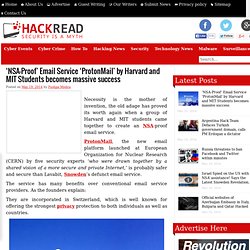
ProtonMail, the new email platform launched at European Organization for Nuclear Research (CERN) by five security experts ‘who were drawn together by a shared vision of a more secure and private Internet,’ is probably safer and secure than Lavabit, Snowden’s defunct email service. The service has many benefits over conventional email service providers.
As the founders explain: They are incorporated in Switzerland, which is well known for offering the strongest privacy protection to both individuals as well as countries. Fun, interesting science? 10 amazing online sources. In today’s TED Talk, Tyler DeWitt makes a fantastic case for a simple idea: make science fun.
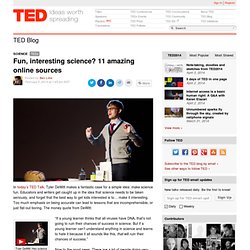
Educators and writers get caught up in the idea that science needs to be taken seriously, and forget that the best way to get kids interested is to… make it interesting. Too much emphasis on being accurate can lead to lessons that are incomprehensible, or just flat-out boring. The money quote from DeWitt: Artificial graphene could outperform the real thing. A new breed of ultra thin super-material has the potential to cause a technological revolution.
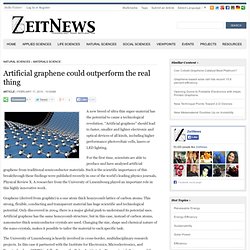
“Artificial graphene” should lead to faster, smaller and lighter electronic and optical devices of all kinds, including higher performance photovoltaic cells, lasers or LED lighting. For the first time, scientists are able to produce and have analysed artificial graphene from traditional semiconductor materials. Such is the scientific importance of this breakthrough these findings were published recently in one of the world’s leading physics journals, Physical Review X. A researcher from the University of Luxembourg played an important role in this highly innovative work. Forsiden - Green Carbon.
How to Heat Your Room for 15 Cents a Day. Quantum mechanics and the new technological future. Federico Pistono Interview. 'Quantum Internet': Towards realization of solid-state quantum network. (Phys.org) —Researchers at TU Delft in the Netherlands have managed to bring two electrons, three meters from each other, into a quantum- entangled state.

This result marks a major step towards realizing a quantum network that can be used to connect future quantum computers and to send information in a completely secure way by means of 'teleportation'. The results have been published online on April 24 in Nature. Why Computing Won't Be Limited By Moore's Law. Ever. In less than 20 years, experts predict, we will reach the physical limit of how much processing capability can be squeezed out of silicon-based processors in the heart of our computing devices.
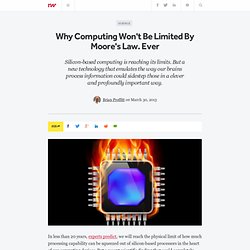
But a recent scientific finding that could completely change the way we build computing devices may simply allow engineers to sidestep any obstacles. The breakthrough from materials scientists at IBM Research doesn't sound like a big deal. In a nutshell, they claim to have figured out how to convert metal oxide materials, which act as natural insulators, to a conductive metallic state. Even better, the process is reversible. Shifting materials from insulator to conductor and back is not exactly new, according to Stuart Parkin, IBM Fellow at IBM Research. Copenhagen Fablab. 19-Year-Old Student Develops Ocean Cleanup Array That Could Remove 7,250,000 Tons Of Plastic From the World's Oceans. 19-year-old Boyan Slat has unveiled plans to create an Ocean Cleanup Array that could remove 7,250,000 tons of plastic waste from the world’s oceans.

The device consists of an anchored network of floating booms and processing platforms that could be dispatched to garbage patches around the world. Instead of moving through the ocean, the array would span the radius of a garbage patch, acting as a giant funnel. The angle of the booms would force plastic in the direction of the platforms, where it would be separated from plankton, filtered and stored for recycling. How a Handful of Countries Control the Earth's Most Precious Materials. To see a list of the raw materials that comprise a cell phone or a computer is to burrow to the planet's core.
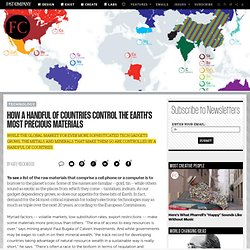
Some of the names are familiar -- gold, tin -- while others sound as exotic as the places from which they come -- tantalum, indium. As our gadget dependency grows, so does our appetite for these bits of Earth. In fact, demand for the 14 most-critical minerals for today's electronic technologies may as much as triple over the next 20 years, according to the European Commission. Myriad factors -- volatile markets, low substitution rates, export restrictions -- make some materials more precious than others.
"The era of access to easy resources is over," says mining analyst Paul Bugala of Calvert Investments. Charts reflect each country's officially reported share of global production, based on latest available data compiled by the European Commission. UTEC - Potable Water Generator. PBS Off Book: Will 3D Printing Change the World? Build your own Electric Car! Google's self-guided car could drive the next wave of unemployment. Almost without noticing it, our world crossed a significant threshold last week.
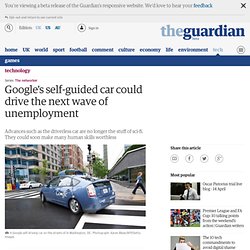
Jerry Brown, the governor of California, signed into law a bill that will allow driverless cars on to his state's roads from 2015. Insofar as most people noticed this event at all, they probably sniffed derisively. For some, it'll be seen as an example of techno-hubris – "flags on the moon stuff" – as one of my acquaintances put it. For others, it will be seen as yet another confirmation of the proposition that the continental United States slopes gently from east to west, with the result that everything with a screw loose rolls into California. Governor Brown signed the bill at Google's HQ in Mountain View.
At the ceremony in Mountain View, Google's co-founder, Sergey Brin, announced the company's intention to bring autonomous vehicles to the market in five years. Printing 3D Houses. 3D printing. 11 Emerging Scientific Fields That Everyone Should Know About. Ellen Jorgensen: Biohacking. Availability: DOW POWERHOUSE™ Solar Shingle. The computer that never crashes - tech - 14 February 2013. Sculpteo’s 3D printing service brings designs to life. Spend a few minutes talking with Clèment Moreau, and you're apt to start dreaming up your own three-dimensional (3D) creations: a customized toy, a work of art, or even a working robot.
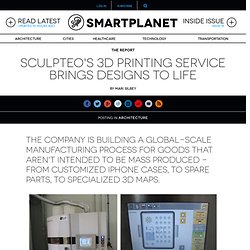
But as co-founder of 3D printing company Sculpteo, Moreau is less interested in hobbyist-only pursuits than he is in what professionals can do with the still-nascent technology. Sculpteo is a 3D printing company, but it doesn't make 3D printers. With facilities in France, America and Israel, Sculpteo maintains its own manufacturing operations for 3D printing services. Companies and individuals send in their 3D renderings, and Sculpteo prints their designs using a process that involves lasers and plastic compounds reduced to a powder form. This is almost the reverse of the engineering revolution sparked by Henry Ford with the Model T automobile. The limitations of in-home 3D printing First, the technology requires a level of technical expertise few consumers possess. Bringing ideas to life. TEDxHamburg - David F. Flanders - "3D Printing: This Century's Most Disruptive Innovation?!" Will Robots Create Economic Utopia?
The robots are coming! Every day it seems we hear another story blaming robots and automation for the disappearance of not only menial jobs, but middle-class ones as well—the kind of work that pays enough to fund a pension, a health-care plan, and a home mortgage. The deepening gloom over jobs runs deeper than robots. Soon, 3D printers could be building houses on the Moon out of lunar dust. A non-causal quantum eraser. Whether a quantum object behaves like a wave or like a particle depends (according to the Copenhagen interpretation) on the choice of measurement apparatus used for observing the system, and therefore on the type of measurement performed.
Anton Zeilinger's team of physicists at the University of Vienna and the Austrian Academy of Sciences has recently taken this phenomenon further than ever. Whether a certain photon behaves like a particle or like a wave depends on the measurement performed on a second photon. Norwegians trap sunlight with microbeads, produce solar cells that are 20 times thinner, cheaper. Researchers from the University of Oslo have used a bunch of “wonderful tricks” to produce silicon solar cells that are twenty times thinner than commercial solar cells.
This breakthrough means that solar cells can be produced using 95% less silicon, reducing production costs considerably — both increasing profits (which are almost nonexistent at the moment), and reducing the cost of solar power installations. Standard, commercial photovoltaic solar cells are fashioned out of 200-micrometer-thick (0.2mm) wafers of silicon, which are sliced from a large block of silicon. Viewpoints ~ Opinion & Analysis.